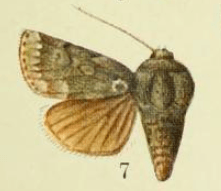Fereday's cutworm facts for kids
Quick facts for kids Euxoa ceropachoides |
|
|---|---|
 |
|
| Illustration of holotype specimen | |
| Scientific classification | |
| Synonyms | |
|
The Euxoa ceropachoides, also known as Fereday's cutworm, is a type of moth. It belongs to the family Noctuidae. This moth is special because it is found only in New Zealand. The New Zealand Department of Conservation says it is "Not Threatened," which means it is not currently in danger.
Contents
About Fereday's Cutworm
How it was Discovered and Named
This moth was first described by a scientist named Achille Guenée in 1898. He used moths collected by Richard William Fereday in a place called Rakaia in Canterbury, New Zealand. Guenée first named it Agrotis ceropachoides.
Later, in 1903, another scientist named George Hampson decided this moth fit better in a different group, the Euxoa genus. So, its name changed to Euxoa ceropachoides. Even today, scientists sometimes discuss if this is the best name for it. But for now, E. ceropachoides is the name we use. The first moth specimen used to describe the species is kept at the Natural History Museum, London.
What Fereday's Cutworm Looks Like
The young moths, called larvae or caterpillars, are brown-grey. They have a wide white stripe on their sides. These larvae can grow up to 35 millimeters long.
Adult Euxoa ceropachoides moths can vary in color. Some are dull grey, but this color is not very common. Because of their varied colors, these moths can sometimes be mistaken for another moth called Agrotis innominata.
Where Fereday's Cutworm Lives
This moth is found only in New Zealand. It lives in the Canterbury region. Besides Rakaia, it has also been found at Kaitorete Spit.
Life and Habits of Fereday's Cutworm
Daily Life and Behavior
The larvae of Fereday's cutworm are active at night. They come out to eat when it's dark. During the day, they hide by burying themselves in the sand. When they are ready to change into adult moths, they form cocoons. These cocoons are also buried shallowly in the sand.
Adult male moths are usually seen flying from June to mid-September. They are often attracted to lights at night. Scientists think that the female moths might have short wings and cannot fly.
What Fereday's Cutworm Eats and Where it Lives
Fereday's cutworm prefers to live in coastal sand dune areas. The larvae of this moth eat different types of grasses and herbs. This includes both native plants and plants brought from other places. One plant they are known to eat is Calystegia soldanella.
Conservation Status
The Euxoa ceropachoides moth is listed as "Not Threatened" by the New Zealand Threat Classification System. This means it is not currently at risk of disappearing.

